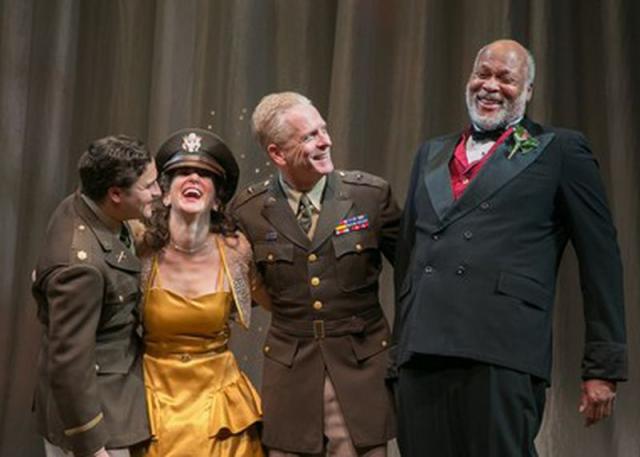
The era is World War II. A soldier sits forlornly alone peeling potatoes in the barracks. Behind him on the wall is a large poster, a reminder to "Buy War Bonds." Weary, he falls asleep. It looks as if he has fallen down on his KP duties. But it isn't long before he's up on his feet not only on leave but also back in his home town as a guest in the Governor's mansion just in time for a Christmas party.
It certainly isn't the worst fantasy Officer Benedick (Scott Wentworth) could imagine. The scene gracefully changes (nice work by designer Michael Ganio) from the barracks to ballroom where numerous dazzling chandeliers adorned with mistletoe will bring added glow to a Much Ado that glitters glibly from start to finish. For starters, the voice of Bing Crosby's crooning "White Christmas," is heard followed by Benedick who is now in the uniform of an officer and joined by others from his regiment.
Except for Benedick's assertion that he is a confirmed bachelor, all the other officers are eager to make merry and dance with all the beautiful young women, friends and relations of Governor Leonato (an imposing Raphael Nash Thompson) all of whom are dressed in their holiday best (gorgeous period-perfect costumes designed by Candida Nichols). Despite all that jitterbugging to the sounds of the Glenn Miller Orchestra and the obligatory conga line, Benedick is still not ready to break the long-standing stand-off of wits that has defined his testy relationship with his beguiling, equally stubborn and most emphatically sharp-tongued cousin Beatrice (Marion Adler). Both being determined not to reveal how and what they really feel for each other despite their having reached middle-age, theirs is a romance that demands some interference from Santa and his corps of similarly bearded helpers.
What a grand idea of director Scott Wentworth has to not only update Shakespeare's most operetta-like and melodramatic comedy to the mid 1940s but to also take on the role of Benedict, which he does with petulance and panache. Among the most charming conceits of this production, however, is the body language that amusingly defined the era, including the soldiers' at-ease posturing.
I was particularly enamored of Adler's facetious poses that lent a special sparkle to her winningly nuanced performance. She really juices up all the superficial fencing/sparring between her and Benedict. A feisty blonde, she allows the sparks to fly especially in the stunning cranberry gown in which she first appears.
Although the secondary lovers Hero (Susan Maris) and Claudio (Charles Pasternak) remain on the sidelines, they are well acted. They are the cause of most of the “Ado” as their plight adds some poignancy to the plot. It takes more than a few contrivances, bordering on the tragic, before their ultimate reuniting. This happens under the watchful, if initially misguided, eyes of the Governor and a pompous, illiterate law enforcer played with subdued brainlessness by Jeffrey M. Bender. He, along with his equally intellectually challenged corps of "shallow fools" gets the play's biggest laughs as he brings to light the truth.
Ultimately, it is Wentworth's heart-warming and delightful vision of the holiday season that really lights up all the Ado.
